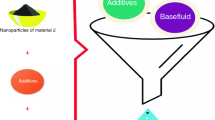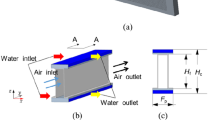Abstract
To optimize the overall heat dissipation performance of the straight channel of a cold plate for lithium battery in vehicles, we used the wavy channel to optimize the structure and uses the face-centered central composite design (FCCCD), which takes the overall thermal-hydraulic performance factor as the response to explore the interaction mechanism of the flow field and temperature field in wavy channel of the cold plate. When the amplitude of the wavy channel is 1 mm and the number of cycles is 4, the overall thermal-hydraulic performance will reach its maximum with an increase of 17.4 % relative to the straight channel. Then, for the coolant, we explored the heat transfer performance of the nanofluid. The heat transfer coefficient of the nanofluid with a volume fraction of 2 % is 117 % higher than that of pure water and does not cause a significant increase in pressure drop.
Similar content being viewed by others
Abbreviations
- a :
-
Channel height
- A :
-
Wavy amplitude
- A C :
-
Bottom area of cold plate
- b :
-
Channel width
- B :
-
Channel width
- c :
-
Separator thickness
- C pf :
-
Specific heat capacity of coolant
- C pn :
-
Nanofluid specific heat
- C :
-
Thermal conductivity coefficient
- C L :
-
Modified thermal conductivity coefficient
- C 1 :
-
Hydraulic diameter coefficient
- d :
-
Channel slope
- d s :
-
Spacing
- d p :
-
Diameter of particles
- D h :
-
Hydraulic diameter
- f :
-
Fanning friction factor
- f i :
-
Body force per unit mass acting on the fluid element
- j :
-
Colburn j factor
- k :
-
Fluid thermal conductivity
- k d :
-
The tensor of the dispersed thermal conductivity
- k n :
-
Thermal conductivity of nanofluids
- L :
-
Wave length
- L c :
-
Channel length
- L h :
-
Hydraulic diameter
- N u :
-
Nusselt number
- p :
-
Static pressure
- P :
-
Cycles
- P :
-
Power
- P r :
-
Prandtl number
- Q :
-
Q criterion
- r :
-
Radial coordinate
- R :
-
Radius of a tube
- S :
-
Strain rate tensor
- S T :
-
Viscous dissipation term
- t :
-
Time
- T :
-
Temperature
- u in :
-
Inlet fluid velocity
- u i,j,k :
-
Velocity components in the X, Y and Z directions
- U :
-
Velocity vector
- V e :
-
Volume of characteristic vortex
- β :
-
Overall thermal-hydraulic performance factor (THPF)
- ϕ :
-
Volume fraction of nanoparticle
- μ :
-
Molecular viscosity coefficient
- λ :
-
Bulk viscosity coefficient
- Ω :
-
Vortex tensor
- Φ :
-
Heat flux
- ρ :
-
Fluid density
- ρ n :
-
Nanofluid density
- ρ f :
-
Coolant density
References
T. Wang, K. J. Tseng, J. Zhao and Z. Wei, Thermal investigation of lithium-ion battery module with different cell arrangement structures and forced air-cooling strategies, Applied Energy, 134 (2014) 229–238.
R. Mahamud and C. W. Park, Reciprocating air flow for li-ion battery thermal management to improve temperature uniformity, J. of Power Sources, 196(13) (2011) 5685–5696.
K. An, P. Barai, K. Smith and P. P. Mukherjee, Probing the thermal implications in mechanical degradation of lithium-ion battery electrodes, J. of the Electrochemical Society, 161(6) (2014) A1058–A1070.
D. B. Tuckerman and R. F. W. Pease, High-performance heat sinking for VLSI, IEEE Electron Device Letters, 2(5) (1981) 126–129.
A. Jarrett and I. Y. Kim, Design optimization of electric vehicle battery cooling plates for thermal performance, J. of Power Sources, 196(23) (2011) 10359–10368.
A. Jarrett, Multi-objective design optimization of electric vehicle battery cooling plates considering thermal and pressure objective functions, Master’s Thesis, Queen’s University, Canada (2011).
B. Banks, Numerical design optimization for thermal and pressure behaviour of multiple curved channel cooling plates in electric-vehicle battery cooling systems, Master’s Thesis, Queen’s University, Canada (2000).
N. R. Rosaguti, D. F. Fletcher and B. S. Haynes, Laminar flow in a periodic serpentine channel, Proc. 15th Australasian Fluid Mechanics Conference (2004).
P. E. Geyer, D. F. Fletcher and B. S. Haynes, Laminar flow and heat transfer in a periodic trapezoidal channel with semicircular cross-section, International J. of Heat and Mass Transfer, 50(17–18) (2007) 3471–3480.
P. E. Geyer, N. R. Rosaguti, D. F. Fletcher and B. S. Haynes, Laminar flow and heat transfer in periodic serpentine minichannels, J. of Enhanced Heat Transfer, 13(4) (2006) 309–320.
Y. Sui, C. J. Teo, P. S. Lee, Y. T. Chew and C. Shu, Fluid flow and heat transfer in wavy microchannels, International J. of Heat & Mass Transfer, 53(13–14) (2010) 2760–2772.
G. Xie, J. Liu, W. Zhang and B. Sunden, Analysis of flow and thermal performance of a water-cooled transversal wavy microchannel heat sink for chip cooling, J. of Electronic Packaging, 134(4) (2012) 341–379.
H. A. Mohammed, P. Gunnasegaran and N. H. Shuaib, Numerical simulation of heat transfer enhancement in wavy microchannel heat sink, International Communications in Heat & Mass Transfer, 38(1) (2011) 63–68.
A. Dominic et al., An experimental study of heat transfer and pressure drop characteristics of divergent wavy minichannels using nanofluids, Heat and Mass Transfer, 53(3) (2017) 959–971.
S. Chari and C. Kleinstreuer, Convective mass and heat transfer enhancement of nanofluid streams in bifurcating microchannels, International J. of Heat and Mass Transfer, 125 (2018) 1212–1229.
S. U.-S. Choi and J. A. Eastman, Enhancing thermal conductivity of fluids with nanoparticles, Proc. of the ASME International Mechanical Engineering Congress and Exposition, San Francisco (1995) 66.
J. A. Eastman, S. U.-S. Choi, S. Li, W. Yu and L. J. Thompson, Anomalously increased effective thermal conductivities of ethylene glycol-based nanofluids containing copper nanoparticles, Applied Physics Letters, 78(6) (2001) 1.
C. H. Chon, K. D. Kihm, S. P. Lee and S. U.-S. Choi, Empirical correlation finding the role of temperature and particle size for nanofluid (Al2O3) thermal conductivity enhancement, Applied Physics Letters, 87(15) (2005) 435.
J. Buongiorno, D. C. Venerus and N. Prabhat, A benchmark study on the thermal conductivity of nanofluids, J. of Applied Physics, 106(9) (2009) 094312.
H. Heidary and M. J. Kermani, Effect of nano-particles on forced convection in sinusoidal-wall channel, International Communications in Heat & Mass Transfer, 37(10) (2010) 1520–1527.
M. K. Moraveji, R. M. Ardehali and A. Ijam, CFD investigation of nanofluid effects (cooling performance and pressure drop) in mini-channel heat sink, International Communications in Heat and Mass Transfer, 40 (2013) 58–66.
J. Rostami, A. Abbassi and J. Harting, Heat transfer by nanofluids in wavy microchannels, Advanced Powder Technology (2018) S0921883118300232.
M. Kalteh, A. Abbassi, M. Saffar-Avval and J. Harting, Eulerian-Eulerian two-phase numerical simulation of nanofluid laminar forced convection in a microchannel, International J. of Heat & Fluid Flow, 32(1) (2011) 107–116.
R. Lotfi, Y. Saboohi and A. M. Rashidi, Numerical study of forced convective heat transfer of nanofluids: comparison of different approaches, International Communications in Heat and Mass Transfer, 37(1) (2010) 74–78.
Y. Xuan and W. Roetzel, Conceptions for heat transfer correlation of nanofluids, International J. of Heat & Mass Transfer, 43(19) (2000) 3701–3707.
Y. Xuan and Q. Li, Heat transfer enhancement of nanofluids, International J. of Heat and Fluid Flow, 21(1) (2000) 58–64.
G. Roy, C. T. Nguyen and P. R. Lajoie, Numerical investigation of laminar flow and heat transfer in a radial flow cooling system with the use of nanofluids, Superlattices and Microstructures, 35(3–6) (2004) 497–511.
S. E. B. Maiga, S. J. Palm, C. T. Nguyen, G. Roy and N. Galanis, Heat transfer enhancement by using nanofluids in forced convection flows, International J. of Heat and Fluid Flow, 26(4) (2005) 530–546.
A. Mokmeli and M. Saffar-Avval, Prediction of nanofluid convective heat transfer using the dispersion model, International J. of Thermal Sciences, 49(3) (2010) 471–478.
J. C. Yang, F. C. Li, W. H. Cai, H. N. Zhang and B. Yu, On the mechanism of convective heat transfer enhancement in a turbulent flow of nanofluid investigated by DNS and analyses of POD and FSP, International J. of Heat and Mass Transfer, 78 (2014) 277–288.
S. Panchal, R. Khasow, I. Dincer, M. Agelin-Chaab and M. Fowler, Thermal design and simulation of mini-channel cold plate for water cooled large sized prismatic lithium-ion battery. Applied Thermal Engineering, 122 (2017) 80–90.
F. R. Menter, Two-equation eddy-viscosity turbulence models for engineering applications, AIAA J., 32 (1994).
J. Y. Wang, W. Yan, S. Li, X. J. Hu, T. Sang and M. Wang, Research on the optimization of micro-channel structure of battery cold plate for electric vehicles, Automotive Engineering, 42(5) (2020) 672–680.
M. M. Ali and S. Ramadhyani, Experiments on convective heat transfer in corrugated channels, Experimental Heat Transfer, 5(3) (1992) 175–193.
G. N. Xie, L. Tian, Q. W. Wang and L. Q. Luo, Comparison of three performance evaluation criteria for heat transfer enhancement in tubes, Annual Meeting of China Society of Engineering Thermophysics (2005) 110–113.
G. Xia et al., Optimum thermal design of microchannel heat sink with triangular reentrant cavities, Applied Thermal Engineering, 31(6–7) (2011) 1208–1219.
J. C. R. Hunt, A. A. Wray and P. Moin, Eddies, streams, and convergence zones in turbulent flows, Center for Turbulence Research Report (1988) 193–208.
Acknowledgments
This work did not receive any specific grant from funding agencies in the public, commercial, or not-for-profit sectors.
Author information
Authors and Affiliations
Corresponding author
Additional information
Jingyu Wang is a Professor at the College of Automotive Engineering, Jilin University, Changchun, China. He received his Ph.D. in Automotive Engineering from Jilin University. His research interests include aerodynamics, heat transfer, and nanofluids.
Rights and permissions
About this article
Cite this article
Hu, X., Liu, Y., Yan, W. et al. Heat transfer enhancement in cold plate based on FVM method and field synergy theory. J Mech Sci Technol 35, 2035–2047 (2021). https://doi.org/10.1007/s12206-021-0420-8
Received:
Revised:
Accepted:
Published:
Issue Date:
DOI: https://doi.org/10.1007/s12206-021-0420-8




